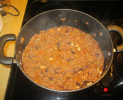HOUSE MUSIC!!!
Posted by By wally at 18 May, at 11 : 00 AM Print
>

House music is a style of electronic dance music that was developed by dance club DJs in Chicago in the early to mid-1980s. House music is strongly influenced by elements of the late 1970s soul- and funk-infused dance music style of disco. House music takes disco’s use of a prominent bass drum on every beat and developed a new style by mixing in a heavy electronic synthesizer bassline, electronic drums, electronic effects, funk and pop samples, and reverb- or delay-enhanced vocals.
House
Stylistic origins : Electro, Funk, Disco, Synthpop, Soul
Cultural origins : African-American, Latino, New York City, Chicago, London, Manchester.
Typical instruments : Synthesizer – Drum machine – Sequencer – Keyboard – Sampler
Mainstream popularity : Large, especially late 1980s and early 1990s United States, United Kingdom and Australia. Still popular among American, British, Australian and South African club goers.
Derivative forms : Rave – Nu jazz – Madchester
Subgenres : Acid house – Click house – Deep house – Funky house – Microhouse – Progressive house – Electro house – Dream house – Hard house – Minimal house – Pumpin’ house – Tribal house – Disco house – Vocal
Fusion genres : Ambient house – Ghetto house – Hip house – Latin house – Tech house
Regional scenes : Chicago house – French house – Italo house – Montreal house – New York house – UK Hard house
Other topics : Notable artists and DJs – Styles of house music

Musical elements
The common element of house music is a prominent kick drum on every beat (also known as a four-to-the-floor beat), usually generated by a drum machine or sampler. The kick drum sound is augmented by various kick fills and extended dropouts. The drum track is filled out with hihat cymbal patterns on the eighth-note offbeats, and a snare drum or clap sound on beats two and four of every bar. This pattern is derived from so-called “four-on-the-floor” dance drumbeats of the 1960s and especially the 1970s disco drummers. Producers commonly layer sampled drum sounds to achieve a more complex sound, filling out the audio spectrum and tailoring the mix for large club sound systems. House music is uptempo music for dancing and has a tempo range of between 118 and 135 bpm. Producers use many different sound sources for bass sounds in house music, from continuous, repeating electronically-generated lines sequenced on a synthesizer such as a Roland TB-303 to studio recordings or samples of live electric bassists, or simply filtered-down samples from whole stereo recordings (from classic funk tracks or any other song). Electronically-generated sounds and samples of recordings from genres such as jazz, blues and synth pop are often added to the foundation of the drum beat and synth bass line. House songs may also include disco or soul-style and gospel vocals and additional percussion. Techno and trance, which developed alongside house music, share this basic beat infrastructure, but they usually eschew house’s live-music-influenced feel and Black or Latin music influences in favor of more synthetic sound sources and approach.
History
Precursors
House music is the descendant of the 1970s dance style of disco, which blended soul, R&B, funk, salsa, rock and pop with a progressive, pro-diversity message. In the late 1970s, disco songs began incorporating electronic sounds, such as Giorgio Moroder’s landmark production of Donna Summer’s hit single “I Feel Love” from 1977. In the same year, Kraftwerk’s album Trans-Europe Express began being played in New York discos; this album contains a number of the elements and samples that later appeared in techno and drum and bass.
In 1984, Lime released an album with a style dubbed “HiNRG”, which moulded the late 1970s sounds of Giorgio Moroder and Kraftwerk into a catchy club style with beatbox programming and breakdown sections. M and M’s club mixes and Jesse Saunders – “On and On” (1984/1985) had many elements of electronic dance music that developed into the house music sound, such as synths (including the 303) and minimal vocals. On and On was the first recognised house release to be pressed and sold to the general public and often cited as the ‘first house music record’. House music also incorporated other influences, such as New Wave, Reggae, European synthpop, industrial and punk as well as the emerging hip hop style. House music DJs experimented with new editing techniques and electronic instruments, such as remixing, sampling, synthesizers, and sequencers.
Etymology
The origins of the term “house music” are disputed. The term may be derived from the name of a club called the The Warehouse, which was one of the nightclubs that became popular among the teenagers living in the Chicago area in the late 1970s and early 1980s. The Warehouse was patronized primarily by gay, black and Latino men, who came to dance to DJ Frankie Knuckles’ mix of classic disco, European synthpop, new wave, industrial, and punk recordings. Knuckles released his dance tracks and mixes on D.J. International Records as well as on the Trax Records label. These dance tracks became known as house music. The legendary club gained considerable fame in the mid 70s and grew tremendously towards the end the 70s. Knuckles production’s increased at that time, and his mix of the Jamie Principle song “Your Love” is considered by many the track that was the launching pad for house.
Chip E.’s recording “It’s House” may also have helped to define this new form of electronic music. Chip E. claims the name came from methods of labelling records at the Imports Etc. record store, where he worked in the early 1980s; music that DJ Knuckles played at the Warehouse nightclub was labelled in the store “As Heard At The Warehouse”, which was shortened to simply “House music”.
Larry Heard, aka “Mr. Fingers”, claims that the term “house” reflected the fact that many early DJs created music in their own homes, using synthesizers and drum machines, including the Roland TR-808, TR-909, and the TB 303 Bassline synthesizer-sequencer. These synthesizers were used to create a house music subgenre called acid house.
Juan Atkins, an originator of Detroit techno music, claims the term “house” reflected the exclusive association of particular tracks with particular DJs; those tracks were their “house” records (much like a restaurant might have a “house” salad dressing).

(PARADISE GARAGE NEW YORK CITY)
Chicago years: early 1980s – late 1980s
Main article: Chicago house
Not everyone understands House music; it’s a spiritual thing; a body thing; a soul thing.
– From a track produced by Eddie Amador
House music was developed in the houses, garages and clubs of Chicago and Detroit, and it was produced for local club-goers in the “underground” club scenes, rather than for widespread commercial release. As a result, the recordings were much more conceptual, longer than the music usually played on commercial radio. House, techno, electro and hip-hop musicians used analog synthesizers and sequencers to create and arrange the electronic elements and samples on their tracks.
House music “humanized” the new electronic instruments by combining live traditional instruments and percussion and soulful vocals with preprogrammed electronic synthesizers and “beat-boxes”.
Main stream record stores often did not carry these 12 inch vinyl singles, as they were not available through the major record distributors. In Chicago, records stores such as Importes Etc., State Street Records, JR’s Music shop and Gramaphone Records were the primary suppliers of this music. The record-store Importes Etc, is believed to be where the term “house” was introduced as a shortening of “Warehouse”.
The music was still essentially disco until the early 1980s when the first stand-alone drum machines were invented. House tracks could now be given an edge with the use of a mixer and drum machine. This was an added boost to the prestige of the individual DJs. Underground club DJs like Ron Hardy and radio jocks The Hot Mix 5 played Italo Disco tracks like “Dirty Talk” and the “MBO Theme” by Klein M.B.O., Early B-Boy Hip Hop tracks such as Man Parrish’s “Hip Hop Be Bop” and Afrika Bambaataa and the Soul Sonic Force’s Planet Rock and Looking for the Perfect Beat as well as electronic music by Kraftwerk, these genres were influential to the Chicago genre of House.
Jesse Saunders “Jes Say Records” who had club hits with more “B-boy Hip Hop” oriented tracks like “Come to Me” by Gwendolyn and “Dum Dum” as well as the Italo Disco influenced “Under Cover” by Dr. Derelict released the first Chicago home made house hit, “On and On” (1984) which had hypnotic lyrics, driving bassline, and percussion. This was the first house record pressed and sold to the general public and presaged many later genres of electronic dance music such as acid trance.
In 1985, Mr Fingers’s landmark “Can You Feel It?”/”Washing Machine”/”Mystery of Love” showed a jazz-influenced, lush, sound that was created using a Roland TR-707 and Juno 6 synthesizer. This song helped to start the trend for the Deep house genre, which had a slower beat of 110-125 bpm. In the same year, Chip E.’s “It’s House” is a good example of the Chicago House Music style. In 1986, Phuture’s “Acid Trax” (1986) showed the development of a house music subgenre called acid house which arose from experiments with a 303 machine by Chicago musicians such as DJ Pierre.
Early house recordings were Jamie Principle and Frankie Knuckles’ “Your Love”; “On and On” by Jesse Saunders (1985) and Chip E.’s “The Jack Trax” featuring the songs “It’s House” and “Time to Jack”, which used complex rhythms, simple bassline, sampling technology, and minimalist vocals. By 1985, house music dominated the clubs of Chicago, largely in part due to the radio play the music received on 102.7 FM WBMX which was the brainchild of Program director Lee Michaels through WBMX’s resident DJ team, the Hot Mix 5.
The music and movement was also aided by the electronic music revolution – the arrival of cheap and compact music sequencers, drum machines (the Roland TR-909, TR-808 and TR-707, and Latin percussion machine the TR-727) and bass modules (such as the Roland TB-303) gave House music creators even wider possibilities in creating their own sound. The acid house subgenre was developed from the experiments by DJ Pierre, Larry Heard (Mr. Fingers), and Marshall Jefferson with the new drum and rhythm machines.
Many of the songs that defined the Chicago house music sound were released by DJ International Records and Trax Records. In 1985, Trax released “Jack the Bass” and “Funkin’ with the Drums Again” by Farley Jackmaster Funk. In 1986, Trax released “No Way Back” by Adonis, Larry Heard’s (as Fingers Inc.) “Can You Feel It?” and “Washing Machine”, and an early house anthem in 1986, “Move Your Body” by Marshall Jefferson, which helped to boost the popularity of the style outside of Chicago.
In 1987, Steve ‘Silk’ Hurley’s “Jack Your Body” was the first House track to reach No.1 in the UK Top 40 pop chart. 1987 also saw M/A/R/R/S’ “Pump Up The Volume” reach No.1 in the UK Top 40 pop chart. In 1989 Hurley transformed Roberta Flack’s soft ballad “Uh Oh Look Out” into a boisterous dance track. S’Express’s “Theme from S’Express” (1988)is an example of a disco-influenced, funky acid house tune. It uses samples from Rose Royce’s song “Is it Love You’re After” over a Roland 303 bassline. In 1989, Black Box – “Ride on time” (which sampled Loleatta Holloway’s 1980 disco hit, Love Sensation) hit number 1 in the UK top 40 and Technotronic’s song “Pump Up the Jam” (1989) was one of the early house records to break the top 10 on the US pop charts. A year later, Madonna’s “Vogue” went to number one on charts worldwide, becoming the highest selling single on WEA up to that time. In 1992, Leftfield’s song “Release the Pressure” helped to introduce a new subgenre of house called progressive house.
House music also had an influence of relaying political messages to people who were considered to be outcast of society. It offered for those who didn’t fit into mainstream American society, especially celebrated by many black gays. Frankie Knuckles made a good comparison of House saying it was like “church for people who have fallen from grace” and Marshall Jefferson compared it to “old-time religion in the way that people just get happy and screamin’” (30). Deep house was similar to many of the messages of freedom for the black community. Both House CDs by Joe Smooth, “Promised Land” and Db “I Have a Dream” give similar messages of Martin Luther King’s “I Have a Dream” speech. House was also very sexual and had much mystic in it. It went so far as to have a “eroto-mystic delirium” (31). Jamie Principle’s “Baby Wants to Ride” begins in a prayer but surprisingly is about a dominatrix who seduces a man to “ride” her through the rest of the song. House dance itself is a lot older than house music, which arose in the late 1970s upon the end of the disco era during the times of such nightclubs as Chicago’s Warehouse, New York’s Loft and Paradise Garage. House dance takes from many different dance elements such as the Lindy era, African, Latin, Brazilian, jazz, tap, and even modern.
House dance has been debatingly broken down in 3 styles: Footwork, Jacking, and Lofting. It includes a variety of techniques and sub-styles that include skating, stomping, and shuffling. It also incorporates movements from many other sources such as whacking, voguing, Capoeira, tap, and Latin dances such as salsa. A wide variety of the movements came from jazz and bebop styles and even from African and Latin descent.
One of the primary elements in house dancing is a technique that came from Chicago that involves moving the torso forward and backward in a rippling motion, as if a wave were passing through it. When this movement is repeated and sped up to match the beat of a song it is called jacking, or “the jack.” All footwork in house dancing is said to initiate from the way the jack moves the center of gravity through space
House music especially Deep House was a jarring kind of genre in music which brought the immoral and different aspect of the sexual and minority in the forefront. House was definitely concerned with the sensuality of the body and setting oneself free– without the worry of outside barriers.





>Influence can be defined as the power exerted over the minds and behavior of others. A power that can affect, persuade and cause changes to someone or something. In order to influence people, you first need to discover what is already influencing them. What makes them tick? What do they care about? We need some leverage to work with when we’re trying to change how people think and behave.
http://www.onlineuniversalwork.com
Charles, 14 years ago